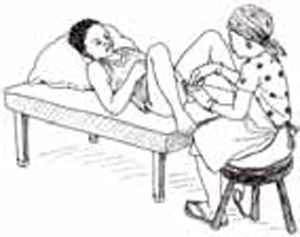Wound infection
Wound infections in the puerperium usually affect torn tissues in the perineum, infection of an episiotomy (an incision made to widen the vaginal opening to let the baby pass through), or a surgical wound in the abdomen after a caesarean birth conducted at a health facility.
In general, wound infections become apparent on the third or fourth postpartum day and are diagnosed on the basis of erythema (reddening of the area of infection), and the tissue overlying the affected area thickens, gets warm and is painful to touch. It may drain yellowish pus from the wound site, and may occur with or without fever.

Treatment of perineal wound infections includes relieving pain with paracetamol, and bathing with warm water in which one teaspoon of salt has been dissolved for every litre of water. If there is pus coming from a wound on the perineum, further drainage of the pus can be achieved by compressing the area with a cloth soaked in warm salty water.
In the case of a woman who also has fever and chills, and you suspect there is pus which is not draining out of the wound, you should refer her to the next higher health facility so that she can be treated with antibiotics. If she has an abscess, it may need to be drained surgically. Most patients respond quickly to the antibiotics once the wound is drained. Antibiotics are generally continued until after the patient has no fever for 24-48 hours.
Abdominal wound infections are generally treated at a hospital, so refer such women to the next higher health facility.